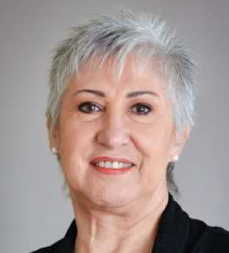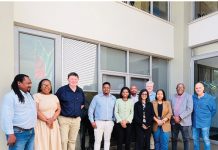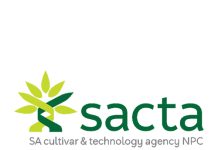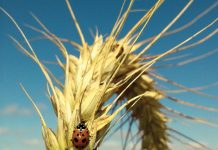
SA Graan/Grain contributor
Minister of Agriculture, Land Reform and Rural Development, Thoko Didiza, launched the National Biosecurity Hub at the University of Pretoria (UP) on Tuesday 11 October, saying that it will play a major role in consistent and fair trade, especially under the African Continental Free Trade Agreement (AfCFTA) which promises to increase intra-African trade.
Biosecurity poses a threat to national food security and to food safety. It is a cross-cutting priority for government and industry, and is shared across all agricultural industries because it encompasses not only the health of plants and animals, but also microbiological contamination and invasive weeds.
To enhance biosecurity in South Africa, the Department of Science and Innovation (DSI) and the Department of Agriculture, Land Reform and Rural Development (DALRRD), in collaboration with UP, established the hub on the Future Africa campus after more than two years of negotiations.
The overarching aim of the hub is to provide sanitary and phytosanitary (SPS) capacity building, information and research services to clients in the public and private sectors, to strengthen biosecurity and to meet the SPS requirements of international trade.
Minister Didiza confirmed that, as an international trading partner, South Africa is a signatory member of both the World Trade Organisation Agreement on the application of Sanitary and Phytosanitary Measures (WTO SPS Agreement) and the International Plant Protection Convention (IPPC) as well as the World Organisation for Animal Health (OIE) and the Codex Alimentarius. That means it is required to align its SPS measures with the relevant international and national obligations to facilitate safe international trade in plants, animals and their products.
- SPS Agreement (1995) – Application of food safety and animal and plant health regulations comprising the laws, rules, standards, and procedures that governments employ to protect humans, animals, and plants from diseases, pests, toxins and other contaminants.
- IPPC (1951) – Multilateral treaty to secure coordinated, effective action to prevent and to control the introduction and spread of pests of plants and plant products. Its network of international partners includes ten regional plant protection organisations that coordinate national plant protection organisations (NPPOs). There are currently some 184 contracting parties of which 50 are in Africa.
- OIE (1924) – Coordinating, supporting and promoting animal disease control in 181 member countries.
- Codex Alimentarius (1963) – A collection of internationally recognised standards, codes of practice, guidelines and other recommendations relating to food, food production, food labelling and food safety.
The minister said that industry and government now plan to cooperate and coordinate efforts. The National Biosecurity Hub will consolidate efforts and integrate management strategies while consortiums will be stablished to co-fund it. She emphasised that government is responsible for the regulatory framework, but others can add to it.
Dr Phil Mjwara, director-general of DSI, pointed out that the Biosecurity Hub was a key intervention for these two departments and will address matters highlighted in the National Bio-economy Strategy, the DSI’s Decadal Plan and also the Economic Reconstruction and Recovery Plan as well as the Agriculture and Agro-Processing Master Plan.
Director of Agricultural Biotechnology at the DSI, Dr Maneshree Jugmohan-Naidu, indicated that risks may be known, entering from neighbouring countries, or emerge when introduced accidentally through international trade. She said such pests or diseases can lead to losses in both the agricultural and forestry industries and that such invasions have recently occurred in South Africa, resulting in a significant impact on the economy.
Dr Marinda Visser, director of Strategic Projects and Partnerships at Innovation Africa, UP, said that partnerships are important and can lead to economic prosperity of producers, the industry and the country. As coordinating body operating under the mandate of the designated regulatory authorities, the hub will facilitate collaborative working arrangements between stakeholders from government, industry, growers, scientists and community members directly affected by biosecurity threats, rather than having these groups act in isolation.
CEOs from various commodity organisations attended the launch and voiced their support for the Biosecurity Hub which aims to ensure biosecurity threats are identified and dealt with timeously and appropriately. The hub will consist of technical experts from industry and research institutions that cooperate with government to build the national SPS capacity.
Four main activities needed to establish a biosecurity hub were identified and will be jointly coordinated between DALRRD and relevant stakeholders.
The first step requires system analysis in order to evaluate the current status of the national biosecurity system. A needs assessment will help to prioritise the activities, resources and planning of the organisation. Because the South African agricultural sector is export-orientated, comprehensive evaluations are critical to determine where research and capacity investments should be prioritised.
This hub should provide support for the technical cooperation programme of the National Plant Protection Organisation of South Africa (NPPOZA) with regard to the regulatory environment surrounding biosecurity issues that form part of the NPPO mandate and also trade protocols that require survey data on the distribution of pests and diseases of interest.
Regulations and policies require revision from time to time as new information becomes available or the threat of biosecurity pests and pathogens changes. Biosecurity investments also depend on the prioritisation of biosecurity threats to ensure the responses deployed maximise returns.
The hub also plans on entering into formal service delivery agreements with industry, research institutions and universities to support and augment DALRRD’s capacity and to negotiate market access. Export commodities undergo pest risk analyses which are specific for each commodity and each country South Africa targets. The additional capacity will ensure that surveys on the distribution of pests and diseases of interest and associated research projects facilitate an enabling trade environment.
A rising concern is the growing list of plant pests and diseases in South Africa. Research and comprehensive surveillance will be of utmost importance for early detection of new risks so that effective control measures are instituted. Industry role-players are already involved in pest and disease surveys to support DALRRD in terms of SPS requirements.
The Biosecurity Hub will prioritise research projects and could also focus research on specific topics of interest to the NPPOZA such as pest biology; identification and diagnostics; pest surveillance methods and procedures; inspection methods; treatments; pest risk analysis procedures and pest control methods. In addition, the hub will prioritise and initiate research projects on quarantine pests and pathogens.
South Africa’s national phytosanitary capacity comprises individuals, organisations and systems whose function is to protect plants and plant products from pests and to facilitate safe trade. The hub is positioning itself to implement the required training and mentoring of capacity outside of government by establishing an internship programme in biosecurity and phytosanitary issues to support capacity development for the NPPOZA. Interns who complete their internship will be placed with DALRRD for further training and to provide additional capacity to the NPPOZA.
Comprising industry, academia, science councils and government role-players, the Biosecurity Hub will facilitate collaborative efforts in the national system of innovation to support the prevention, reduction and management of crop and animal disease and other matters related to food safety in South Africa and contribute to sustainable agricultural production and the safe trade of agricultural products, services and processes.

















